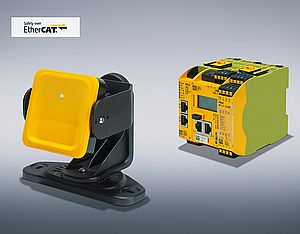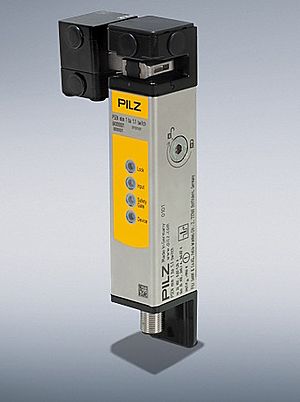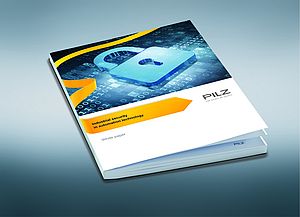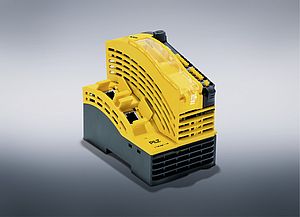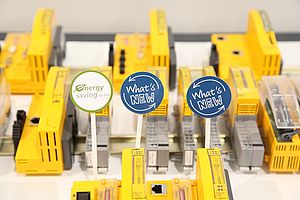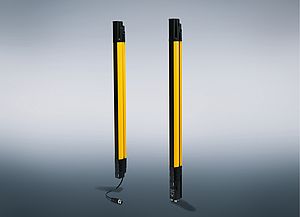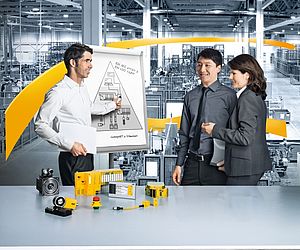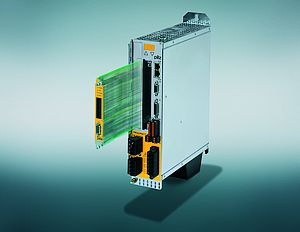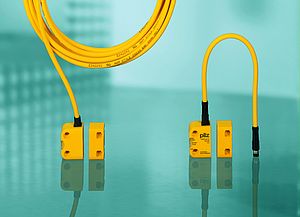With the Health & Safety Executive about to commence on-site inspections of hand-fed platen presses, users of this high-risk machinery need to ensure that their presses meet the required safety standards. By working closely together, two companies have developed a novel, high integrity safety solution for a hand-fed platen press, which uses an array of light beam sensors and a modular safety control and monitoring system.
A collaborative development project between two UK-based companies has resulted in a much safer working environment for operators of a hand-fed platen (die cutting) press. In November 2009, machinery safety specialist Pilz Automation Technology and SCA Display UK, a manufacturer of Point-of-Display (POD) products for retail customers, began working together to improve the safety of a hand-fed platen press at SCA Display’s production plant in Shenstone.
Part of SCA, SCA Display UK’s Shenstone plant employs around 80 staff and manufactures a wide variety of point-of-sale and POD products, mostly custom designed products made from cardboard. The factory uses a wide range of machinery, including digital and silkscreen printers, die cutters, folding & gluing machines and platen presses. Most of the die cutting uses semi-automatic presses, but one of the presses is hand-fed, which is used for short runs and one-off customer specials.
Ian Clews, Facilities Manager at Shenstone, has been working with platen presses for more than 30 years and SCA are members of the Confederation of Paper Industries, where machinery safety is high on the agenda. “Quite frankly, the use of these machines has been a concern for many years, particularly in the dwell mode. With two fatalities in the UK in recent years, users of these machines need to review their safety systems.”
“A typical hand fed platen press closes with a tremendous force, often with the operator’s body in close proximity. This means that operator safety is extremely critical. At Shenstone we have a continual improvement policy which instigated further upgrades to our platen press to ensure that additional operator safety measures.”
HSE Safety Alerts and Inspections
Ian Clews is not alone in his views on the need to improve the safety of hand-fed platen presses. In the UK, the Health & Safety Executive (HSE) has recently issued safety alerts to users of hand-fed platen presses. It is estimated that in the UK alone, there are between 1,000 and 2,000 such presses that require safety upgrades, mostly operated by companies in the printing and packaging industries. Most of the high-risk machines fall into the 1.4m to 2m-width range.
The HSE is currently considering issuing alerts to users in order to raise awareness of the potential dangers of whole body access between the platens of these machines when operating in the ‘dwell’ mode. The alerts are in response to two fatalities since 2008 in the UK, where operators were crushed between the platens as they intervened during normal production. In both cases, the hand-fed machine was being used in the dwell mode and the power to the platen was not isolated before the intervention occurred and so the safety devices fitted to the machine did not prevent the platens closing on the operator.
“During the setting process, waste removal, replacement of lay stops or mis-feed retrieval, even with the most safety conscious operators may try to beat the dwell and climb onto the platen press bed or lean into the machine. Whilst between the fixed and moving platen beds the operator is not detected by any of the usual safety systems,” explains Ian Clews.
According to the HSE, the latest hand-fed platen presses are much larger than their predecessors and many users now use the machine’s dwell mode to either give them more production flexibility or to speed up the machine’s output, as this mode can often double the speed of operation. On most hand-fed platen presses, climbing onto the platen from the normal operating position in front of the machine can be done without operating the safe edge that is normally fitted to the leading edge of the lower platen. This means that if a safe system of work is not followed, including isolating the machine, the platen may then continue to cycle if it is being used in the dwell mode and the protective devices will not automatically be triggered.
Further investigation by the HSE has showed that standards of guarding and working practices on many existing, larger hand-fed platen presses need to be improved significantly. HSE has announced that it will commence on-site inspections of hand-fed platen presses in October 2010.
In his presentation to a group of machinery safety suppliers at the HSE’s Birmingham offices on 12th July 2010, Tim Small, HM Principal Inspector at the HSE, stated: “The HSE deems hand-fed platen presses as high risk machines. Enforcement action will be taken against any UK firms that aren’t taking appropriate action to meet these new safety expectations.”
Employee Safety-Driven Approach
In November 2009, SCA Display UK decided to improve the safety of its hand-fed platen press at Shenstone to better protect employees. Ian Clews contacted Pilz Automation Technology to discuss possible safety solutions. “By this time, I had already devised several concepts for upgrading the safety of the platen press, but needed to talk to a machinery safety specialist supplier such as Pilz about how the solution could be realised from a technological viewpoint. I also wanted the solution to be modular, enabling a best option for employee protection rather than a cost option. It was critical that we worked with a supplier that had in-depth knowledge of current machinery safety legislation and standards, but with the ability to then apply that knowledge to developing the most appropriate safety system for our machine,” says Ian Clews.
Chris Sloan (Area Sales Engineer) and Stewart Robinson (Consultant Engineer) at Pilz Automation Technology have worked closely with Ian Clews on the platen press project since early 2010. Chris Sloan says: “Initially we visited Shenstone to assess and analyse the platen press and to discuss safety issues and potential solutions. SCA wanted a working solution based on a modular safety platform that would include all the necessary hardware and software, tailored to suit the machine.”
Stewart Robinson adds: “One of Ian Clews’ favoured concepts was to use an array of light beam sensors that would monitor the side and platens in order to detect any violation of the machine’s danger zone whilst the press was closing. As far as we are aware, the solution we’ve developed is the only one of its kind in the UK, where light beam sensors are being used to monitor the area directly above the moving platen.”
The overall safety solution is based on Pilz’s PNOZmulti modular safety system. PNOZmulti is multifunctional, freely configurable and is ideal for monitoring safety functions such as Emergency-Stop, safety gates and light barriers, as well as performing standard control functions. Rather than hard wiring, safety circuits can be generated on a PC using PNOZmulti’s intuitive configuration software. This configuration can then be stored on a memory card and downloaded to the PNOZmulti base unit.
The solution incorporates a PNOZmulti base unit, with input and output expansion modules to control all aspects of machine safety and control. “We wrote a functional specification for the press, then engineered a solution based on these functional safety requirements. We supplied all the hardware, including the light beam array and safety controller, as well as writing all the software code for the application,” states Stewart Robinson.
The hand-fed platen press at Shenstone is fitted with a number of general purpose safety devices such as trip bars, interlocked guards, right and left hand emergency stops, safety mat, front safe edge, lumbar bar, safety gate key switch, left and right side light curtain. All these devices have the same functional safety requirements, which are to prevent all hazardous movement by ensuring that the clutch safety valve is de-energised and that the main motor is stopped, and to prevent unintended restart. The target safety integrity level for each General Safety Function is SIL 3 (EN 62061), equivalent to PLe according to EN ISO 13849-1.
SCA’s Safety Solution
The machine now uses an array of PSENop4S light beams supplied by Pilz. As Ian Clews explains: “We did have a few teething problems based around alignment of the sensors, but this was down to the original machine mountings, which were not robust enough to provide a solid foundation for the light beam sensors. We quickly resolved this issue by developing more robust bearing mountings, which enable the sensors to be adjusted more easily. We also developed an infra-red sighting device that simplifies the alignment of the sensors.”
The light beam array now detects a violation of the danger zone whilst the press is closing. This is achieved by sequentially muting the laser beams as the press closes. If any beam is broken before it has been muted, the press clutch safety valve is de-energised immediately bringing the hazardous movement to a stop. Once the final beam has been broken (press closed) the beams remain muted until the press cam switch has operated, signalling that the press is at the ‘home’ position. The muting points are derived from the simulation of press position carried out within the PNOZmulti control system. The application also includes checking that the press cam switch operates correctly in each press cycle.
It should be remembered that this solution must be accompanied with robust, safe systems of work, training, regular maintenance and risk assessments.
“The services provided by Pilz were exceptionally good and I cannot fault them at all. Any modifications or software updates were carried out quickly as and when required and technical support from Pilz engineers was excellent. The working relationship was very close and has resulted in a truly collaborative solution. The project itself was completed successfully on the 16th of July and the press was handed over to our production team two weeks later,” Ian Clews concludes.






